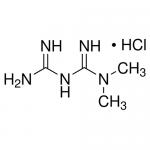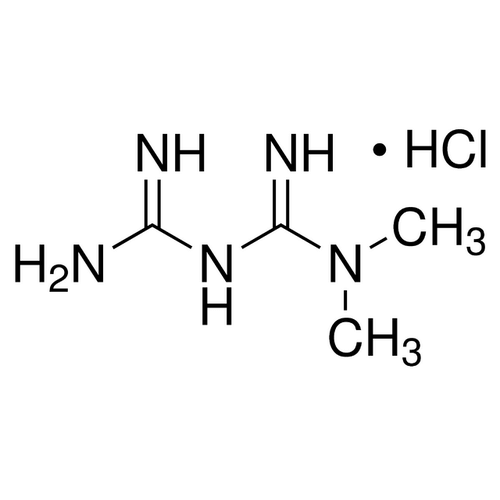| Product Name | Metformin Hydrochloride |
| Description |
Autophagy inducer |
| Purity | >97% |
| CAS No. | 1115-70-4 |
| Molecular Formula | C4H11N5•HCl |
| Molecular Weight | 165.6 |
| Field of Use | Not for use in humans. Not for use in diagnostics or therapeutics. For in vitro research use only. |
Properties
| Storage Temperature | -20ºC |
| Shipping Temperature | Shipped Ambient |
| Product Type | Inducer |
| Solubility | Soluble to 100 mM in water and to 50 mM in DMSO. |
| Source | Synthetic |
| Appearance | White crystalline powder. |
| SMILES | [H+].CN(C)C(N=C(N)N)=N.[Cl-] |
| InChI | InChI=1S/C4H11N5.ClH/c1-9(2)4(7)8-3(5)6;/h1-2H3,(H5,5,6,7,8);1H |
| InChIKey | OETHQSJEHLVLGH-UHFFFAOYSA-N |
| Safety Phrases |
Classification: D2B- Toxic Material Causing Other Toxic Effects, Moderate skin irritant, Moderate eye irritant Safety Phrases: S22 - Do not breathe dust. S24/25 - Avoid contact with skin and eyes. S36/37/39 - Wear suitable protective clothing, gloves and eye/face protection. Hazard statements: H302- Harmful if swallowed. H315- Causes skin irritation. H319- Causes serious eye irritation. Precautionary statements: P305 + P351 + P338- IF IN EYES: Rinse cautiously with water for several minutes. Remove contact lenses, if present and easy to do. Continue rinsing. |
| Cite This Product | Metformin Hydrochloride (StressMarq Biosciences Inc., Victoria BC CANADA, Catalog # SIH-395) |
Biological Description
| Alternative Names | N,N-Dimethylimidodicarbonimidic diamide hydrochloride |
| Research Areas | Autophagy, Cancer |
| PubChem ID | 14219 |
| Scientific Background | Metformin Hydrochloride is a widely used antidiabetic agent that improves insulin sensitivity and lowers blood glucose levels. In neuroscience, Metformin has emerged as a promising neuroprotective compound. It activates the LKB1-AMPK pathway, which inhibits mTORC1 and promotes autophagy—a key mechanism for clearing misfolded proteins and damaged organelles in neurons. Metformin has been shown to reduce alpha-synuclein phosphorylation and aggregation, making it relevant in Parkinson’s disease research. It also exhibits anti-inflammatory and antioxidant effects, contributing to its potential in Alzheimer’s disease and other neurodegenerative conditions. Metformin’s ability to modulate energy metabolism and cellular stress responses positions it as a candidate for therapeutic repurposing in brain aging and neurodegeneration. |
| References |
1. Kirpichnikov D., et al. (2002). Ann Intern Med. 137(1): 25-33. 2. Caton P. W., et al. (2010). J Endocrino;. 205(1): 97-106. 3. Feng Y. H., et al. (2011). J Cell Mol Med. 15(4): 825-36. 4. Huang H., et al. (2013). Autophagy. 9(2): 175-95. |



Reviews
There are no reviews yet.